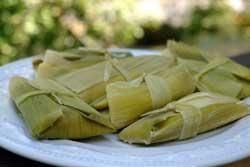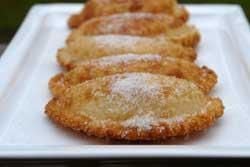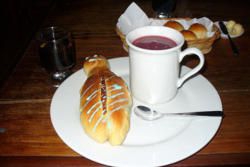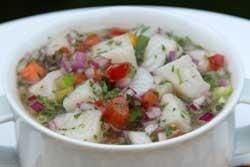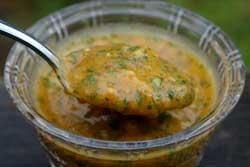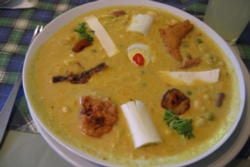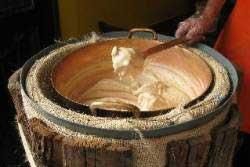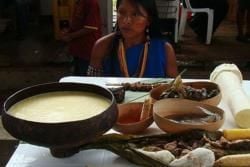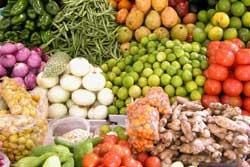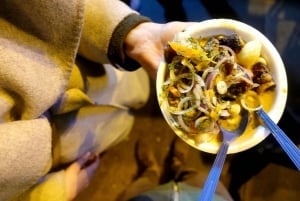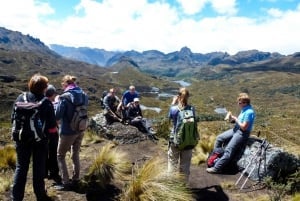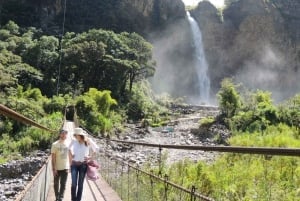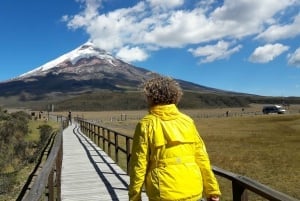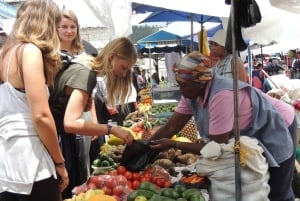Ecuadorian Cuisine
Ecuadorian cuisine is as varied as the climate and geology of the country are. It is known for its fabulous exotic fruits, high quality fish and seafood, and the countless varieties of Andean potatoes. Across the country you will find a broad spectrum of national and regional dishes, rich and tasty, where the varied ingredients and spices used will give you an array of different sensations. Ecuadorian cooking is famous for enhancing the natural taste of food; spices are widely used, especially pepper, cumin, coriander, parsley, garlic, "achiote" (annatto), and more; most seasoning is done with salt and lemon.
The diet in the Andean highlands is based on potatoes and corn, in all their varieties. The Andean "chicha", a popular alcoholic beverage, is made from fermented corn. Other important ingredients are different kinds of cereals and grains, like Quinoa and Barley, and root vegetables like Mellocos, Ocas, Mashua, and Camote (sweet potatoes), which people are trying to rescue as an important part of the local diet. Amongst the meats, you can find "cuy" (guinea pig), called like this for the cuy cuy sound it makes, which is considered the finest of meats by indigenous people; it is prepared rotisserie style to keep texture and taste, and the whole animal is laid on the plate. Cuy also plays an important part in other aspects of the Andean culture. Pork meat is also very popular and present in most traditional dishes, the most known are "fritada" and "hornado", fried and roasted respectively.
On the coast, for sure seafood is the order of the day, accompanied by white rice, "menestra" (cooked lentils or red beans), and "patacones" (fried green plantain); you will be offered different kinds of fish and mollusk, fried, cooked, or in "ceviche", spiced with cilantro, peanuts, or coconut water; green plantain ("verde") is also an important part of the diet, whether as an ingredient of a dish or by itself, as a patty ("tortita"), an "empanada", or a "bolón" (big ball ), among others.
In the rainforest, cassava, or yuca as it is called here, is a common item and the main element in the native people's diet. Fried or boiled, this starchy root is used to complement numerous other dishes. The Amazonian "chicha" is made by fermenting cassava. The rainforests are also reputed for their exotic fruits like tree grapes, peach palm fruit, pitahaya, arasha, and others.
Ecuadorian food is mild but you will almost always be offered "Ají" to spice it up. Ají is a hot sauce made of a spicy red pepper which is grown throughout the country. Ají sauces range from mildly spicy to burning, so try just a little at first and act accordingly. In the provinces of Carchi and Loja especially, ají is made very hot. It can be added to any dish, be it soup, empanadas, or meat, anything goes. The locals say that if you have to eat displeasing food, it is easier to do so with ají. This may be advice that is worth keeping in mind.
The list of typical Ecuadorian dishes, bites, and treats is very long, just a few are mentioned here, the most popular and special ones which you should try when you visit Ecuador:
• Several kinds of Empanadas (turnovers): de Morocho – fried corn dough stuffed with ground beef, carrot and peas; de Verde - fried or baked green plantain dough filled with cheese, meat, or chicken; de Viento - fried wheat flour dough filled with cheese. All of them are great spiced up with Ají (hot pepper sauce), provided you like hot sauce.
• Cazuela – a peanut-flavored green plantain-based soup filled with fish or some other kind of seafood, served hot and with white rice on the side.
• Locro is a typical Ecuadorian soup. "Locro de papas" is prepared with potatoes, milk, and cheese and colored yellow with annatto shortening ("achiote", little red seeds which are sold in the market and which are fried in shortening or oil to obtain the food coloring). Other types of locros are the "yaguarlocro" (blood soup) made with lamb meat and blood; and the pork-rind locro. The town of Guayllabamba near Quito is the home of this dish.
• Caldo de patas – a broth-based soup made with beef hoof.
• Humita – a corn bread cake steamed in a cornhusk. Great with coffee.
• Llapingachos – potato patties stuffed with cheese and fried until crispy on the outside. Served with a fried egg, avocado, and curtido. Ambato is the place to eat this recipe in their brand new and clean main market—always go with friends.
• Roasted Guinea Pig (Cuy) – a traditional highland dish, the whole guinea pig is roasted and served with potatoes with cheese sauce and lettuce.
• Fanesca - A seasonal Easter dish, fanesca is a thick soup made of codfish and 12 beans and grains, representing the 12 apostles. It is served around Easter time in almost every Ecuadorian home and many restaurants, accompanied by "masitas" (fried little flour dough balls) or empanadas, boiled eggs, avocado, fried sweet plantain, and cheese.
• Ceviche – a cold seafood dish made by marinating raw fish or clams in lemon juice and then adding onion, tomato, and cilantro and other spices to it. It can also be made of shrimp, but shrimp is cooked previously. In the highlands, the seafood is sometimes replaced with avocado, hearts of palm, or chochos (lupine seeds). It is commonly served with popcorn, chifles (fried plantain chips), and/or tostado (toasted corn). Traditionally, the best ceviches were available all along the coast, but nowadays you can find excellent ceviche in the highlands cities too.
• Helado de Paila - an ice-cream made by hand in a "paila" (a large pan). This sweet Ecuador dish is originally from Ibarra but nowadays can be found throughout the highlands in many different flavors.
• Fritada – fried pork served with corn on the cob, avocado, hominy, potatoes, fried ripe plantain ("maduro frito"), and curtido (a common onion and tomato salad).
• Hornado – pork, roasted until very tender, then roasted again inside the pig’s skin, giving the skin a crunchy consistency. Served with hominy, llapingachos, avocado, and curtido. The Ecuadorian capital of "Hornado" is Sangolquí, 45 minutes by bus from Quito.
• Colada morada - a thick berry-and-flour-based drink, served hot or cold, sipped or eaten with a spoon. Usually served with "guaguas de pan", baby shaped and decorated bread buns. Served only around the Day of the Dead celebration (November 1 & 2).
• Encocado – fried fish or shrimp covered with a coconut sauce, and served with rice and fried plantains. Esmeraldas, Manabi, Santa Elena and Guayas are the best places to eat this recipe.
• Churrasco – a thin cut of beef served with fried egg, French fries, avocado, fried plantains, rice, and curtido.
• Seco de pollo/chivo/carne – a hearty stew of chicken, goat, lamb or beef made with beer, onions, tomatoes, and herbs. Served with rice and potatoes or manioc root. Traditionally from the coast.
Budget travellers can eat in local restaurants. Classic almuerzos (lunches) and meriendas (dinners) usually consist of a soup, a main course, juice and dessert for between $1.50 and $3.
There are many restaurants that serve typical Ecuadorian dishes, just look or ask for "comida típica". The main markets also serve traditional dishes along with other dishes.


